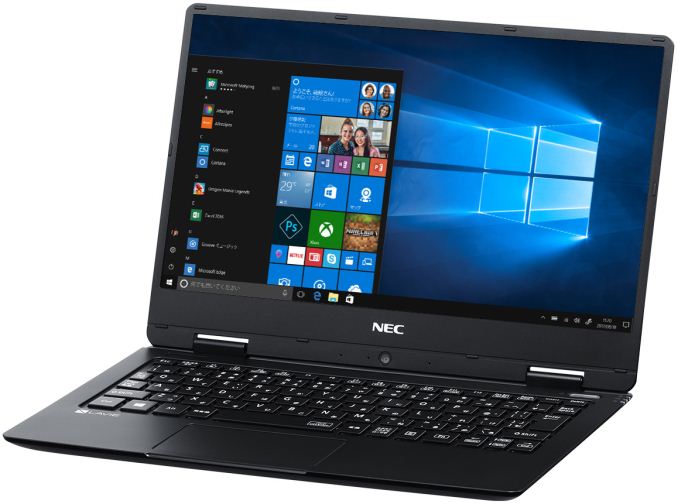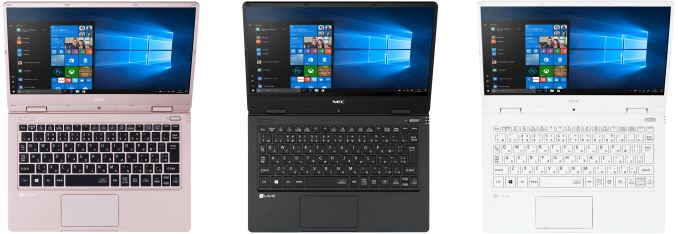NEC 2018 LaVie Note Mobile: Fanless 12.5” Core i7 with 12hr Battery, Under 2 Lbs
by Anton Shilov on January 29, 2018 11:00 AM EST- Posted in
- Notebooks
- Systems
- Intel
- NEC
- Laptops
- Kaby Lake-Y
- Lavie
- Lavie Note Mobile

This month, NEC has introduced its first 2018 LaVie notebook: The LaVie Note Mobile. The LaVie line is known due to its design philosophy of being lightweight: when we had a chance to hold the LaVie Z back in 2015, it was so light it felt like picking up an empty shell of a system. For 2018, the Lavie Note Mobile is the newest member of the family, being updated from the previous model. This design has a 12.5-inch screen, and since Intel has not released any new ultra-low-voltage CPUs recently, NEC had to retain usage of Kaby Lake-Y SoCs. Despite featuring a larger LCD, the new 2018 Lavie Note Mobile still weighs in the range of two pounds (~900 grams) and is rated to work for nearly 12 hours on one battery charge.
NEC’s Lavie Note Mobile is the company’s most compact laptop lineup. The previous-gen Lavie Note Mobile came with 11.6” IGZO IPS FHD displays, but for the 2018 (NMx50/KA) family NEC decided to update it in three ways: an 12.5” IPS FHD monitor, reduce the system’s thickness to 17 mm, and increase the amount of DRAM on high-end models. The LCD gained nearly an inch of real estate, but lost its IGZO material in the process. Compared with the 2017 model, it is worth noting that the updates cause a couple of minor changes: the 11.7-hour rated battery life is slightly down from 13, and the weight is slightly up by a few grams.
The increase of the display size, reduced thickness and enhanced RAM size will make the new Lavie Note Mobile more competitive against ultra-compact products like Apple’s MacBook, so NEC’s design decisions look rather logical. As for visual aesthetics, NEC also adjusted its Lavie Note Mobile lineup this year: the new notebooks will be available in pink, pearl white and pearl black.
Overall other specifications of the 2018 NEC Lavie Note Mobile range are similar to the 2017 versions: at retail, available systems are based on Intel’s Kaby Lake-Y SoCs: the Core i5-7Y54, the Core m3-7Y30 or the Celeron 3965Y. In order to get the Core i7-7Y75 model, according to PC Watch, the unit has to be bought directly from NEC. The Kaby Lake-Y SoCs feature two cores, Intel’s UHD Graphics 615, and are around 4.5 W rated TDP, which is of course their main feature that enables NEC to use passive cooling. The new Lavie Note Mobile machines are equipped with 4 or 8 GB of dual-channel LPDDR3 memory (up from 4 GB on previous-generation Lavie NM laptops), as well as a Samsung PM871b SATA SSD featuring 64 GB, 128 GB or 256 GB capacity. The higher-end Core i7-based SKU also has a 512 GB PCIe SSD option.
When it comes to connectivity and I/O interfaces, everything looks pretty standard: the NEC Lavie Note Mobile laptops are equipped with a 802.11ac + Bluetooth 4.1 wireless module, two USB 3.0 Type-A ports, a 3.5-mm TRRS audio connector, a Windows Hello-compatible fingerprint reader, an HDMI output, a webcam located under the display, a built-in microphone, stereo speakers, an SD card reader and so on. All the physical ports are located on the backside of the notebook. Some might consider the lack of a USB Type-C port in 2018 a drawback.
A sharp-eyed reader might also notice a rather small space bar that is barely six centimeters long. While this looks like a problem for people using European languages, this is not a problem for Japanese, who do not have to use spaces often, which is why short spacebars are common on laptops for the Land of the Rising Sun.
| The NEC Lavie Note Mobile General Specifications | |||||
| NM550/KA | NM350/KA | NM150/KA | |||
| Display | 12.5" non-glossy IPS 1920×1080 resolution |
||||
| SoC | Core i5-7Y54 Core i7-7Y75* |
Core m3-7Y30 | Celeron 3965Y | ||
| RAM | 8 GB LPDDR3 | 4 GB LPDDR3 | |||
| Storage | 256 GB SSD SATA 512 GB SSD PCIe* |
128 GB SSD SATA | 64 GB SSD SATA | ||
| Camera | 720p webcam | ||||
| Wireless | 802.11ac Wi-Fi 867 Mbps Bluetooth 4.1 |
802.11ac Wi-Fi 433 Mbps Bluetooth 4.1 |
|||
| I/O ports | 2 × USB 3.0 Type-A 1 × HDMI SD card reader |
||||
| Audio | Integrated speakers 1 × TRRS 3.5-mm jack for headset Yamaha AudioEngine software enhancements |
||||
| Dimensions | 289 × 197.5 × 17 mm | ||||
| Weight | 904 - 925 grams | ||||
| Battery | unknown | ||||
| OS | Windows 10 Home Windows 10 Pro* |
||||
| Fingerprint | Yes | ||||
| Finish | Pink Black White |
||||
| Price | ¥144,800 ($1330) | ¥124,800 ($1148) | ¥104,800 ($963) | ||
| Notes | *Available only directly from NEC | ||||
NEC’s Lavie Note Mobile is already available. The most affordable Celeron-based model costs ¥104,800 ($963), whereas the more advanced Core i5-powered SKU is priced at ¥144,800 ($1330).













32 Comments
View All Comments
MrSpadge - Wednesday, January 31, 2018 - link
The screen at the top also improves ergonomics (apart from when using the webcam), as your eyes don't have to look down as much, or you'll buckle your neck down a bit less. Not a bad choice for such tiny machines & screens.digiguy - Monday, January 29, 2018 - link
How about a 13.3" laptop at less than 1.8 pounds (788gr), with proper webcam, and full 15w i7 with 16GB RAM? With all the full ports and USB C charging from anything, including smartphone chargers and powerbanks? That's my Samsung Notebook 9.Hurr Durr - Tuesday, January 30, 2018 - link
Proclaiming an ethernet-deprived notebook with only 2 actually useful USBs as "all the full ports" machine is ridiculous even for a shill like you .digiguy - Tuesday, January 30, 2018 - link
man this is a 13.3" ultrabook, not a gaming laptop, it's thinner than the macbook pro and lighter than even the 12" macbook, there is absolutely no room for an Ethernet port (the usb A take 100% of the thikness of the laptop). How many current ultrabook have an Ethernet port? None. So you don't know what an ultrabook is... This is not a desktop replacement, if you want more ports go with a bigger notebook. By modern ultrabook standard, having 2 USB A, one full size HDMI, one USB C (plus headphone, microsd and charging port) is quite impressive these days, when the lightest laptops have only usb c ports, and surface pros only one USB A and minidisplay...). Let alone a keyboard with 1.5mm travel...nerd1 - Monday, January 29, 2018 - link
So totally eclipsed by new samsung notebook 9 pen, which has larger screen (13.3"), built in wacom EMR pen and vastly better processor (Kaby Lake R)HStewart - Monday, January 29, 2018 - link
Keep in mind this is both previous generation CPU 7th and not 8th and that it is also fanless and not a quad core U processor. My guess is intel with skip 8th generation with Y series and go directly to 9th with 10nm. It also possible that with 10nm, the U series will be fanless.digiguy - Monday, January 29, 2018 - link
FYI Samsung notebooks have a silent mode toggle, that makes the laptop silent by throttling the CPU and GPU. I don't know if in silent mode it's faster than a Y processor, but I think it gives you the choice. Personally I can't stand fan noise at all. So for me it must either be fanless (and there are even fanless 8th gen quad cores) or have a silent mode...HStewart - Monday, January 29, 2018 - link
I actually own a Samsung Galaxy TabPro S - Windows 10 12in tablet - I also have Dell XPS 13 2in1 - like both form factors - but I think the 2in1 is better.I personally pretty big into Samsung Tablets - have a Galaxy Tab S - like it so much purchase a S3
Your Samsung Notebook 9 looks like a very nice 2in1 and much better than this NEC - I still think later this year when 10nm are expected to come out will be time to upgrade.
HStewart - Monday, January 29, 2018 - link
I just can't wait to see what happens with the Y series and 10nm. We can only guess what is coming up next - my guess is Quad core with 24hr battery life - Intel is not going to let the threats of Windows on Qualcomm hold them down.I personally like the Y series - they are quite and give enough power - even to run applications like Photoshop - and Microsoft Office. Not every one needs extremely powerful GPU for gaming.
IntelUser2000 - Monday, January 29, 2018 - link
The early review of the Qualcomm laptop doesn't get 24 hour battery life, and neither is a 10nm Intel chip, unless they get gaming laptop sized batteries.10nm Intel chips will improve battery life, but not because of the process. Rather, it'll be due to things like McIVR, and improved component selection. Skylake has been a downgrade from Broadwell due to not using IVR, but starting with Cannonlake they will use it again. The 300 series chipsets should also improve battery life due to better integration of components like the CNVi WiFi.